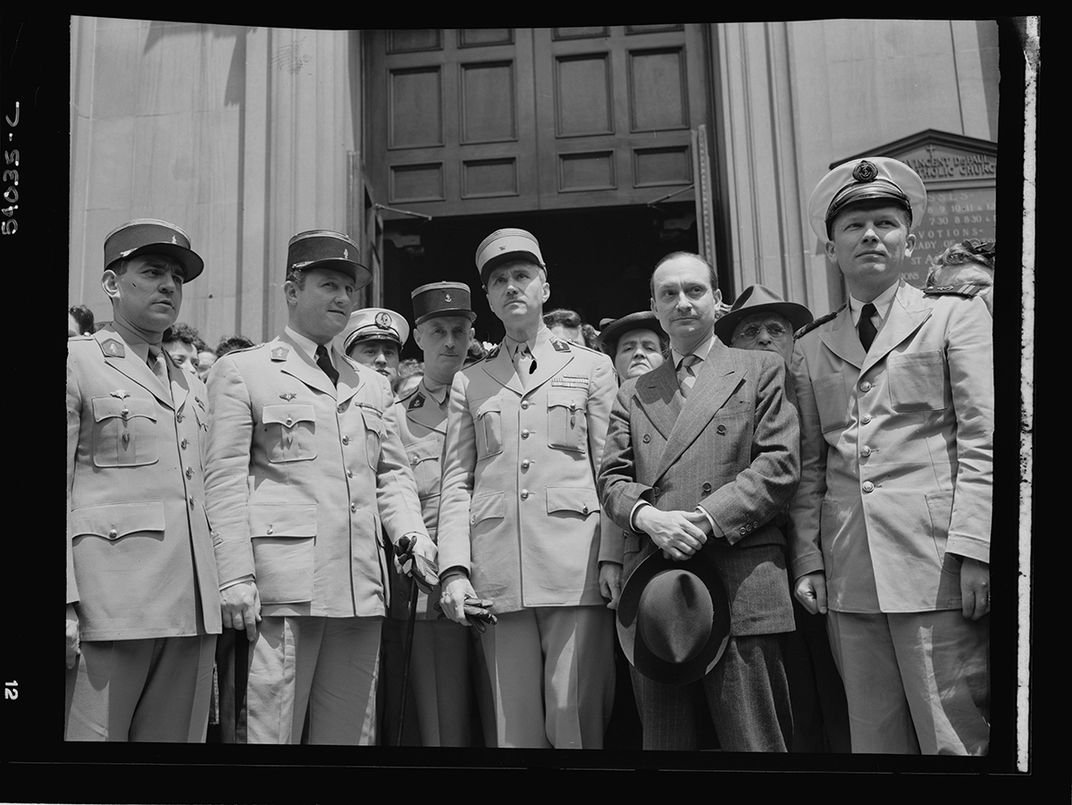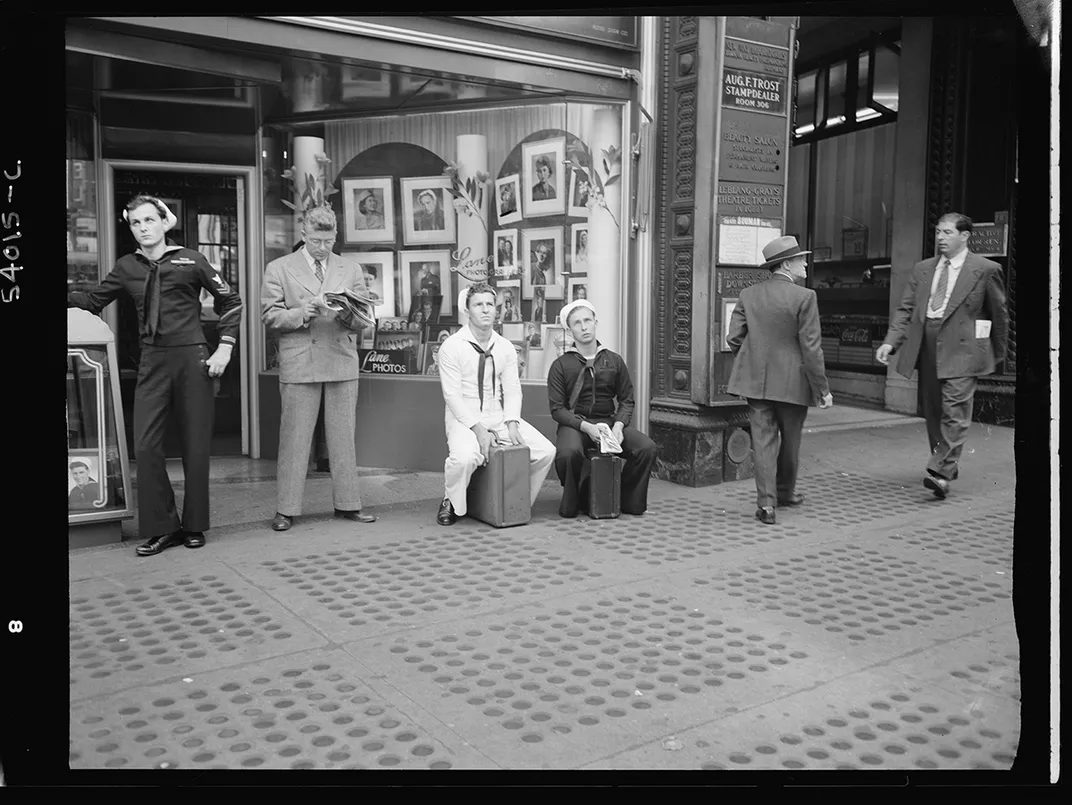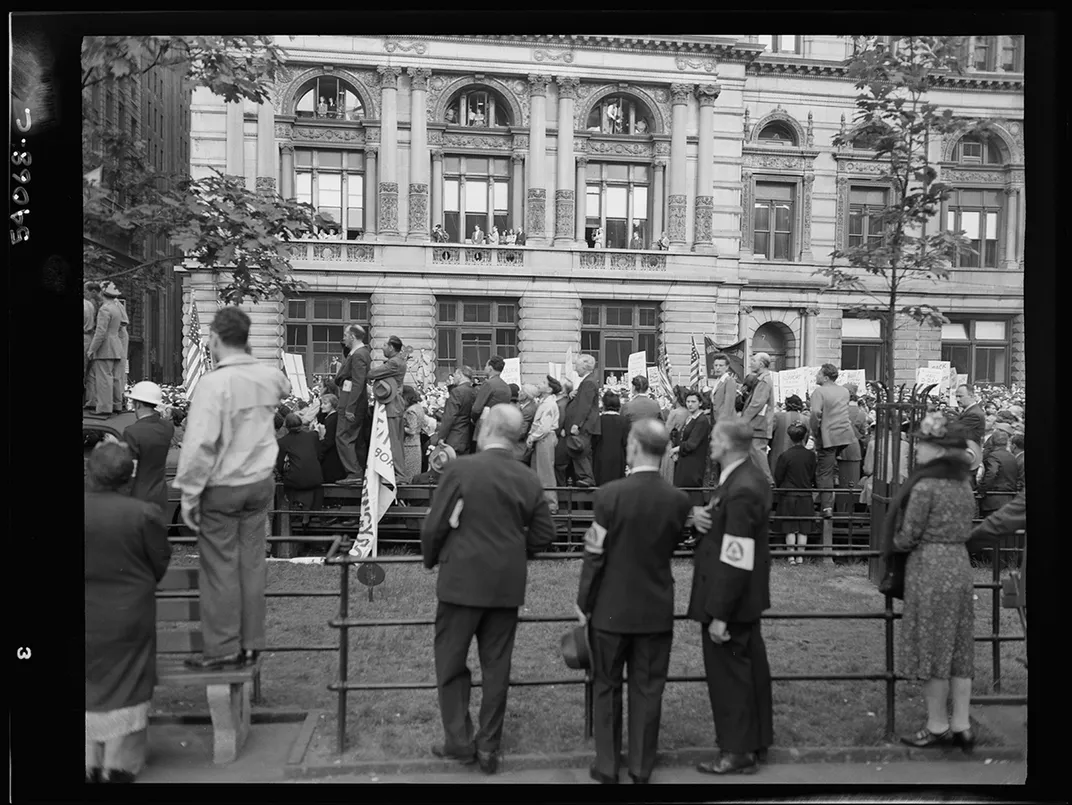Photos From the Hours After Americans Heard About the D-Day Invasion
Black and white photos from the Library of Congress show New Yorkers rallying, praying, on June 6, 1944
When Allied troops stormed the beaches of Normandy, in what would become the largest seaborne invasion in history and a crucial turning point in the war, most Americans slept—news of the invasion wouldn't reach the United States shores until 3:32 a.m. EST, when General Eisenhower's Order of the Day, a message recorded for the troops going into the invasion, was read over American radio stations. President Roosevelt himself wasn't briefed of the invasion's status until a mere 30 minutes before the American public found out—he remained on the phone with generals until 9 a.m., then met with the press at 4 p.m..
In the interim, news of the invasion spread rapidly throughout the U.S.—radio stations broadcast information as they acquired it, while newspapers printed bold headlines announcing the invasion (many newspapers at the time, like the Denver Post, published in the afternoon, allowing them to cover the story the afternoon of June 6), and some Americans went to specially scheduled religious services to pray. President Roosevelt addressed the American public directly for the first time that evening, during his radio address. The address itself was conceived as a prayer, with Roosevelt asking God to bless the American work effort. He also called on the American people to continue their prayers into the coming days, stating:
Many people have urged that I call the Nation into a single day of special prayer. But because the road is long and the desire is great, I ask that our people devote themselves in a continuance of prayer. As we rise to each new day, and again when each day is spent, let words of prayer be on our lips, invoking Thy help to our efforts.
Roosevelt's sentiments were shared by many Americans, who turned to prayer and religion throughout the day. "The reaction of many Americans, whenever they found out what was happening that day, was to attend religious services," says Keith Huxen, the Samuel Zemurray Stone senior director of research and history at the National World War II Museum. "Churches and synagogues were reportedly packed across the country."
New information was difficult for American media outlets to obtain; CBS World News' radio program from the day makes multiple references to German media broadcasts, which were the main source of updated information. In Philadelphia, the mayor sounded the Liberty Bell for the first time in over a century. In New York City, the New York Stock exchange observed two minutes of silence and in Madison Square, WNYC held a D-Day rally, featuring speeches and songs presided over by the city's mayor Fiorello La Guardia. Like Roosevelt, La Guardia led the city in a prayer, telling those gathered—and those listening at home on their radios: "We, the people of the City of New York, in meeting assembled, send forth our prayers to the Almighty God for the safety and spiritual welfare of every one of you and humbly petition Him to bring total victory to your arms in the great and valiant struggle for the liberation of the world from tyranny."
With the Allied troops' success on D-Day, some military officials thought that the invasion would hasten the end of the war. But the prayers that Roosevelt and La Guardia asked for on June 6, 1944 would be needed longer than expected—it would take the Allies until May of 1945, nearly 11 months after D-Day, to finally defeat Nazi Germany.
/https://tf-cmsv2-smithsonianmag-media.s3.amazonaws.com/accounts/headshot/natasha-geiling-240.jpg)

/https://tf-cmsv2-smithsonianmag-media.s3.amazonaws.com/filer/30/7c/307c7d37-8e1a-4f91-855a-b4775d00d594/8d36244u.jpg)

/https://tf-cmsv2-smithsonianmag-media.s3.amazonaws.com/filer/bb/02/bb02b7a5-fcef-4193-b3e4-1ff44462ad62/8d36257u.jpg)
/https://tf-cmsv2-smithsonianmag-media.s3.amazonaws.com/filer/76/4f/764f1078-4e10-451e-8260-21d465bbb587/8d36266u.jpg)
/https://tf-cmsv2-smithsonianmag-media.s3.amazonaws.com/filer/19/97/1997d7bd-aa81-462b-97b9-94b103cd7374/8d36268u.jpg)
/https://tf-cmsv2-smithsonianmag-media.s3.amazonaws.com/filer/50/83/5083e9c5-30c1-4831-bd68-002918142c2a/8d36292u.jpg)

/https://tf-cmsv2-smithsonianmag-media.s3.amazonaws.com/filer/1d/d9/1dd9c1d5-c5dc-46e9-830d-25e58726db32/8d36297u.jpg)
/https://tf-cmsv2-smithsonianmag-media.s3.amazonaws.com/filer/64/e2/64e26f0b-570d-4caf-8f3d-f351220be5b6/8d42342u_and_8d42338u.jpg)
/https://tf-cmsv2-smithsonianmag-media.s3.amazonaws.com/filer/fc/ac/fcacb665-4e47-44f0-844e-b2cbad8ed68a/8d36306u.jpg)
/https://tf-cmsv2-smithsonianmag-media.s3.amazonaws.com/accounts/headshot/natasha-geiling-240.jpg)